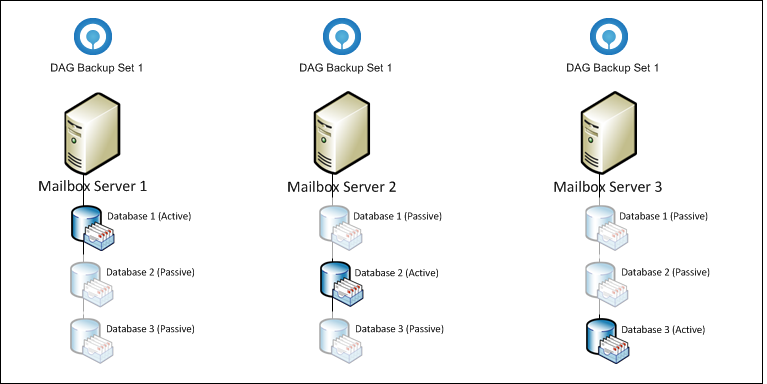For a complete Exchange database backup with DAG, backup the following components must be performed:
Windows System State For the domain controller with Active Directory installed, as part of the restore, the system state must also be restored. Running regular system state backups of the domain controller is therefore crucial, as it ensures that the system state data is synchronized with the Exchange database data. Microsoft Information Store (Exchange 2010 with DAG) The Information Store on all the Exchange 2010 servers within the same DAG contains the data, data definitions, indexes, checksums, flags, and other information that comprise mailboxes in Exchange. Even one of the Exchange servers is down, as long as the active databases on that machine had replicated to other Exchange servers within the DAG, one of the Exchange servers within the DAG will turn the replicated database (passive database) to active database and users can still access to the Exchange mailboxes. Therefore the backup of the database is more important, and our module can help to protect the Exchange database to avoid database corruption. In case you need to do a full protection on all the Exchange servers within the DAG, a full system backup on each Exchange 2010 server within the DAG is required. In addition, the active mailbox databasesU hold data that's private to an individual user and contain mailbox folders generated when a mailbox is created for that user. A mailbox database is stored as an Exchange database .edb file. These active mailbox databases are required to backup, and it can be restore and replace the active mailbox databases when required. In Exchange Server 2010, public folders are an optional feature. Public folder database contains the data, their definitions, indexes, checksums, flags, and other information that comprise any public folders in your Exchange organization. These public folders can be backup, however, due to the Exchange limitation, ie one public folders database can be mounted, it should only restore to an Exchange with no public folder setup or restore to the original machine. Note: OBM is required to install on each DAG member with Mailbox Role, and it will backup all the active database on the same host, passive database will not be backup.

Suggestions: If one of your Exchange Server within the DAG was down and you need to add a new Exchange Server to the DAG, you may refer to the Microsoft Technet to: http://technet.microsoft.com/en-us/library/dd351278.aspx You will need to install OBM, configure and run the schedule backup of the active database(s) on the new Exchange server.
 button to start the New Backup Set Wizard.
button to start the New Backup Set Wizard.